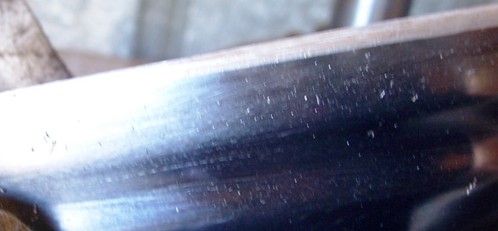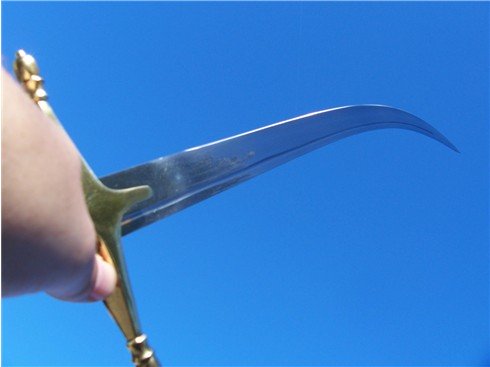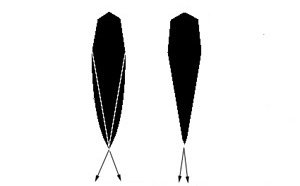Recent Articles
-
Christmas Sword Buying Guide 2025
Dec 03, 25 10:53 PM
Authentic Swords
Some additional defining qualities...
When it comes to selecting authentic swords, the main factors to consider are the construction of the hilt, the type of steel used and the tempering which we cover in our article "A Good Battle Ready Sword: The Basics". But this is just the beginning: the absolute minimum qualities of a real sword...
In this article, we will be looking at some of these more advanced features that separate the baseline functional swords from the real performers.
You'll also see here why this topic has not been introduced earlier, because unlike the baseline requirements, this is something of a grey area. There are no easily identifiable characteristics or hard and fast rules of thumb, but many of these seemingly subtle differences are truly what separates the high performance authentic swords from the multitude of cheap wanna be's ...
Good Handling Characteristics
DISTAL TAPERING
Most authentic swords, particularly medieval swords, had what is known as a distal taper. In other words the blades thickness lessens from the hilt to the tip, sometimes gradually and evenly sometimes only really beginning from the mid point.
This is one characteristic that is often (though certainly not always) absent on modern medieval sword replicas yet a fraction of an inch can make a world of difference to approximating an authentic swords overall weight and balance.
A sword that has the three essential characteristics of a battle ready sword (carbon steel blade, tempering and a full tang) it is possible that you will end up with something that handles little better than a tough, sharpened crowbar.
This may suit some people well enough and there is nothing wrong with that per se, but the reality is that for a cutting sword, the handling and balance are the biggest factors separating authentic swords from the poor performers...
If a sword is too heavy, or if the balance is wrong, it will not be able to reach the ideal velocity to cut its intended target properly. While balance and handling are rather subjective, and there is room for individual preferences (both historically and in a modern context) the reality is that if you look at swords of the same basic type, some handle and cut much better than others. Naturally, with all other things being equal, these better handling swords are the kinds of swords you should seek out whenever possible.
While it is impossible to create hard and fast rules for the various types of swords out there I have attempted to create some basic guidelines a useful rule of thumb on three of the most popular types based on a blades length, weight and point of balance. This is definitely NOT gospel, and the parameters are kept deliberately wide.
However, the majority of good handling swords tend to fall within these parameters. (some extremely well made swords may well defy this oversimplification authentic swords often have a characteristic known as dynamic balance which has as much to do with distribution of mass and how a blade handles in motion than just the weight and point of balance...)
'IDEAL' PARAMETERS BASED ON SWORD TYPE
 Japanese Katana
Japanese KatanaIdeal Blade Length: 27-30"
Ideal Weight: 2-3lbs
Point of Balance: 5-7" from tsuba
 Arming Sword
Arming SwordIdeal Blade Length: 27-32"
Ideal Weight: 2-3lbs
Point of Balance: 3-6" from crossguard
 Ideal Two Handed Sword
Ideal Two Handed SwordIdeal Blade Length: 33-37"
Ideal Weight: 2.8-3.5lbs
Point of Balance: 2-5" from crossguard
Good Edge Geometry
Another thing that separates authentic swords designed for cutting purposes from those that just feel sharp, as well as contributing to (and/or defining) their handling characteristics, is the edge geometry.
The most basic swords out there in the sub US$300 market have what is called a secondary bevel, in other words the blade slopes down towards the edge, and then suddenly, rapidly meets the other side which is fine on a knife, but a questionable quality for authentic swords.
 Classic example of a secondary bevel
Classic example of a secondary bevelIn some cases, swords with a secondary bevel can cut quite well depending on their mass, balance and other characteristics. For example, the Cold Steel Shamshir shown below has a secondary bevel but actually cuts extremely well...

However a sword that is not all that well balanced can sometimes be saved by the correct edge geometry. And a sword that handles well that has a more traditional geometry is doubly effective for it.
In the case of Japanese swords, many of the cheaper ones are very sharp to the touch, but mysteriously do not cut well over extended periods of time with razor sharp edges rolling, chipping or blunting after only a few cuts.

For a Japanese sword designed for frequent cutting practice a hira niku (or appleseed) profile is highly desirable. Cheness Cutlery swords for example, as pictured to the right are designed with this hira niku profile that can sometimes feel deceptively blunt.
I have heard first hand of people who, thumbing the blade across edge were surprised that it did not feel sharp, and then made the mistake of drawing their thumb along it whereupon the hira niku profile cut deep enough to require stitches, and in one case, microsurgery...
Other Factors and Conclusion
Learning about what makes authentic swords so effective is a lifelong process. Each sword is different, and there are many that may not fit so easily within the artificial parameters I have imposed here yet still be excellent pieces in their own right.
Other factors to consider include the swords harmonics in other words, the primary and secondary nodes where the sword vibrates less than the rest of the sword when struck. On most swords they have what is called the Center of percussion (C.O.P.) which can be found by striking the hilt of the sword and observing the area, often around 2/3rds of the way down the blade, that exhibits the least vibration. This primary node, or sweet spot is the ideal point of the sword to deliver the most forceful cuts (on Japanese swords, the area is larger called the Monouchi and is situated in the top 1/3rd of the blade).
Authentic swords will also often exhibit a secondary node, ideally just below the guard, which will prevent shockwaves from traveling into the hilt causing an uncomfortable jarring sensation if it is misplaced.
And all this is just the beginning...
So the question is, how can the beginning sword enthusiast find the most authentic swords on a budget? Swords that are well balanced, with a good edge geometry, the correct weight and handling for their type, and all the other minute factors that make the difference between a good sword and a cumbersome crowbar?
The Answer? Become a voracious reader!
Read books, online articles like this one, forum posts - from as many different sources as possible so you can see the big picture...
There are so many different types of swords and factors to consider when evaluating them that it really is a lifelong process of learning. Each time you feel that you have an answer, more questions reveal themselves. But dont worry about that take it all bit by bit and enjoy the journey!! Its all part of the fun...
I hope this information on authentic swords has been helpful. To return to WARNING: Do not Buy Swords online until you read this first to Authentic Swords some additional defining qualities, click here

Buying Swords Online Can Be DANGEROUS!
Find the Best Swords in the:
Popular & Recommended ARTICLES

The ONLY true free online magazine for sword enthusiasts. Delivered once a month on the 1st day of the month, no filler and no BS, just the latest sword news & info delivered straight to your inbox.












